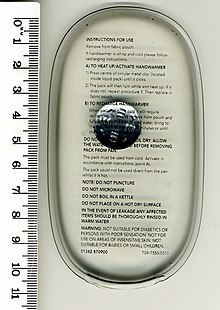Hand warmer

Hand warmers are small (mostly disposable) packets which are held in the hand and produce heat on demand to warm cold hands. They are commonly used in outdoor activities such as hiking and skiing to keep extremities warm and assist insulated clothing. Other types of warmers are available to provide soothing heat for muscular or joint aches.
Depending on the type and the source of heat, hand warmers last between 30 minutes (recrystallisation) to 12–24 hours (platinum catalyst).
Types
Air activated (iron)
Air activated hand warmers contain cellulose, iron, water, activated carbon (to speed up reaction), vermiculite (water reservoir) and salt (catalyst) and produce heat from the exothermic oxidation of iron when exposed to air. They typically emit heat from 1 to 10 hours. [1][2]

Supersaturated solution (crystallization-type)
Crystalisation types of hand warmer generate heat through the exothermic crystallisation of supersaturated solutions (typically sodium acetate) and are usually reusable. These can be recharged by immersing the hand-warmer in very hot water until the contents are uniformly fluid and then allowing it to cool. The release of heat is triggered by flexing a small metal disk in the pad, which generates nucleation centers that initiate crystallisation. Heat is required to dissolve the salt in its own water of crystallisation and it is this heat that is released when crystallisation is initiated.[3] (More at Sodium_acetate#Heating_pad)
This type typically has a shorter heat duration of 20 minutes to 2 hours.[4]

Lighter fuel
LPG hand-warmers use lighter fluid (lighter fuel) or LPG which reacts with a platinum catalyst to release heat by oxidation reactions. These can be re-used by simply refuelling.[5]
Battery
Battery operated hand warmer use electrically resistive heating devices to convert electrical energy in the battery to thermal energy using disposable or re-chargeable batteries. Typically they can last up to 6 hours.
Charcoal
Charcoal hand-warmers provide heat through the burning of charcoal in a special case. These can last up to 6 hours and become comfortably hot. The cases for these usually have felt on the outside and have materials inside that do not burn, but spread the heat evenly such as metal. To activate, one or both ends of a stick of charcoal are lit and then quickly extinguished to create a hot ember. The smouldering stick is then placed inside the case and the case is tightly shut. The charcoal sticks are available from most outdoor activity shops and are fairly inexpensive.
See also
- Instant cold pack
- Heating pad
- Hot water bottle
- Sodium acetate (commonly used in exothermic crystallisation hand warmers)
References
- ^ "Warmer Hands (And Toes) Through Chemistry". ScienceIQ.com. Retrieved 2007-09-03.
- ^ Handwärmer: Warme Hände, heisser Kopf
- ^ "How do sodium acetate heat pads work?". HowStuffWorks. Retrieved 2007-09-03.
- ^ "HotSnapZ FAQ". HotSnapZ.com. Retrieved 2008-01-23.
- ^ "Peacock Pocket Warmers". Hakkin Warmers Co., Ltd. Retrieved 2007-09-03.
